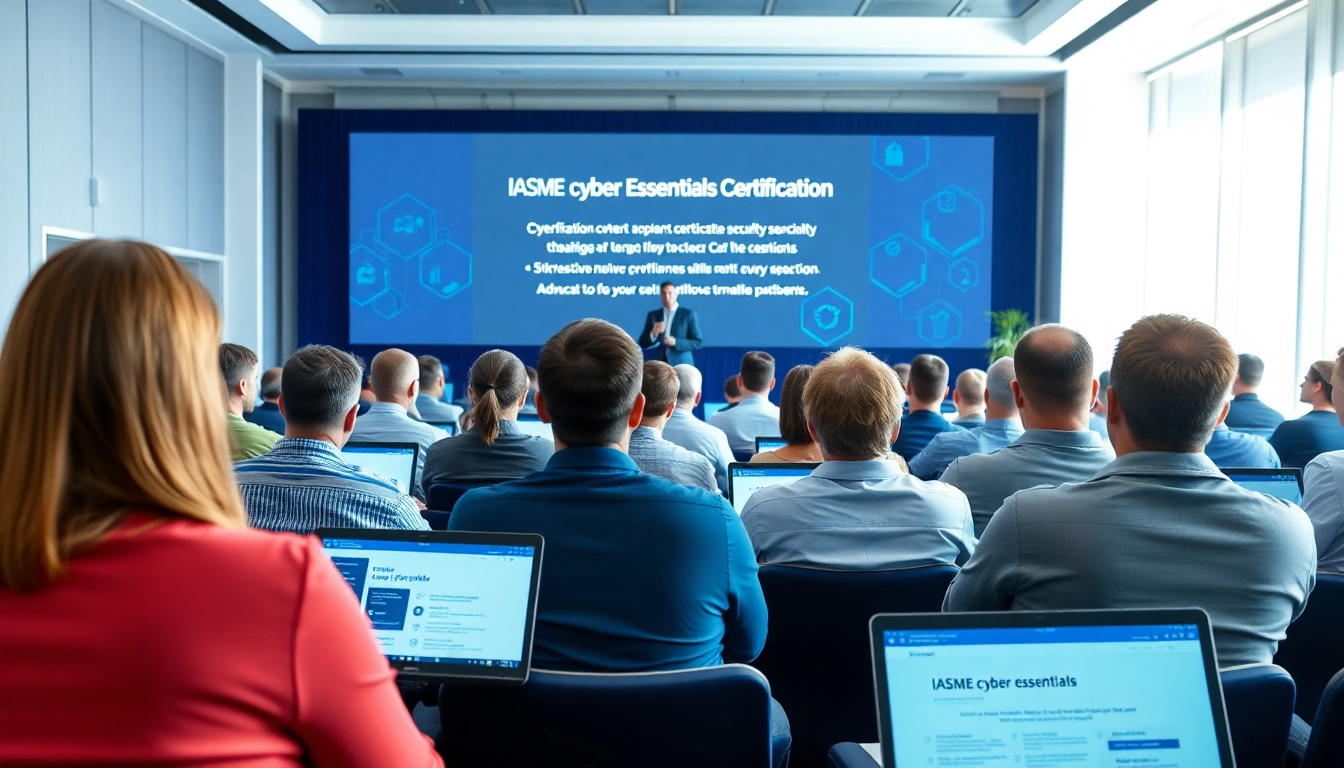What is IASME Cyber Essentials?
Overview of the Certification Standards
IASME Cyber Essentials is a certification framework aimed at helping organizations protect themselves against common cyber threats. It represents a baseline standard for cybersecurity, established with input from the UK Government and supported by the National Cyber Security Centre (NCSC). IASME Cyber Essentials not only serves as a foundation for organizations looking to enhance their cybersecurity protocols but also assists in creating a secure digital infrastructure that fosters trust in digital transactions. The certification focuses on five core controls: secure configuration, boundary firewalls and internet gateways, access control, virus and malware protection, and patch management, which organizations must implement to ensure their systems are robust against cyberattacks. For more detailed information, you can explore the IASME cyber essentials product offerings.
Importance for Organizations of All Sizes
The relevance of IASME Cyber Essentials spans organizations of all sizes, from small businesses to large enterprises. In an era where cyber threats have become increasingly sophisticated, even the smallest entities can fall victim to attacks that exploit basic security flaws. Cyber Essentials aims to bridge this security gap by providing organizations with a clear roadmap of essential cybersecurity measures.
Small enterprises, often lacking the resources or expertise for comprehensive IT security, can particularly benefit from the structured approach offered by Cyber Essentials. By achieving this certification, these organizations can not only protect their sensitive information but also build credibility with potential clients and partners who are increasingly demanding cybersecurity assurances.
Understanding the Five Core Controls
The framework of IASME Cyber Essentials is built around five core controls, which form the bedrock of a secure IT environment:
- Secure Configuration: Ensuring that the organization’s devices and software are configured in a secure manner minimizes vulnerabilities. This involves removing default accounts, changing default passwords, and applying strict user permissions.
- Boundary Firewalls and Internet Gateways: These tools serve as the first line of defense against external threats. Proper configuration ensures that unauthorized access is prevented and only legitimate traffic is allowed.
- Access Control: Access needs to be limited based on user roles and necessity. Implementing the principle of least privilege helps mitigate risks associated with human error or malicious intent.
- Virus and Malware Protection: Regularly updated antivirus and anti-malware programs must be deployed across all systems to detect and neutralize potential threats before they can cause damage.
- Patch Management: Ensuring that all software and systems receive timely updates and patches is vital to close vulnerabilities that cybercriminals may exploit.
The Benefits of IASME Cyber Essentials Certification
Building Customer Trust and Confidence
Achieving IASME Cyber Essentials certification serves as a strong signal to customers and stakeholders that a business takes cybersecurity seriously. In a world where data breaches and cyberattacks are increasingly common, clients are more likely to engage with organizations that can demonstrate their commitment to protecting sensitive information. This certification is not merely a badge; it reassures customers that their data is in safe hands, thus enhancing trust and fostering a long-term relationship.
Reducing Cyber Risk and Vulnerabilities
Cybersecurity threats can range from simple phishing attacks to complex ransomware campaigns. By implementing the five core controls advocated by IASME Cyber Essentials, organizations can significantly reduce their exposure to these risks. By systematically addressing the vulnerabilities that could be exploited by attackers, businesses not only enhance their defenses but also cultivate a culture of security awareness among their employees.
Meeting Regulatory Compliance Requirements
Compliance with industry standards and regulations is becoming increasingly crucial as data protection laws continue to evolve. Achieving IASME Cyber Essentials certification can assist organizations in meeting regulatory requirements for data protection, such as GDPR for companies operating within the European Union. This certification can be a vital element in a broader compliance strategy, serving as a foundation upon which further standards and regulations can be built.
How to Achieve IASME Cyber Essentials Certification
Step-by-Step Certification Process
The process of obtaining IASME Cyber Essentials certification involves several critical steps:
- Self-Assessment: Organizations must first complete a self-assessment questionnaire that evaluates compliance with the five core controls. This self-assessment serves as a diagnostic tool to identify potential gaps.
- Implementation: Based on the self-assessment results, organizations must implement necessary measures to address any vulnerabilities identified.
- Submission: Once the required controls are in place, organizations submit their self-assessment along with any supporting documentation for review.
- Certification: Depending on the results of the review, IASME will issue certification if the organization meets the requirements.
- Renewal and Maintenance: Certification must be renewed annually to maintain compliance, requiring periodic reviews and updates of security practices.
Preparing Your Organization for Assessment
Preparation for IASME Cyber Essentials certification can be a smooth process if approached methodically. Here are some strategies organizations can adopt:
- Conduct a Cybersecurity Audit: An initial audit can help organizations understand their current posture regarding cybersecurity and identify gaps that need to be addressed.
- Engage Employees: Training and awareness programs for employees ensure a cohesive understanding of security best practices, which are vital for maintaining a secure environment.
- Consult with Experts: Engage with cybersecurity consultants or advisors who can provide insights and assistance in preparing for certification.
Common Pitfalls to Avoid
As organizations prepare for IASME Cyber Essentials certification, they may encounter several challenges. To mitigate these risks:
- Neglecting Regular Updates: Organizations must ensure that software, applications, and systems are regularly updated to avoid exploitation by cybercriminals.
- Outdated Security Policies: Revisit and update cybersecurity policies regularly to adapt to evolving threats and compliance requirements.
- Underestimating Employee Awareness: A strong security culture is essential; failing to engage employees in security practices can lead to vulnerabilities.
Maintaining Compliance After Certification
Regular Updates and Reviews
Obtaining IASME Cyber Essentials certification is not the finish line; it is, in fact, the beginning of a continuous journey toward robust cybersecurity. Organizations are encouraged to perform regular audits and reviews of their systems, ensuring that security measures remain effective and up to date.
Continuous Improvement Strategies
After certification, organizations should adopt a mindset of continuous improvement. This might involve implementing feedback loops, gathering metrics on cybersecurity incidents, and adjusting security strategies based on emerging threats. Regularly scheduled training sessions and simulations of cyber incident responses can also foster ongoing security preparedness among employees.
Integrating Certification with Other Standards
Certification to IASME Cyber Essentials can pave the way for pursuing other cybersecurity standards, such as ISO 27001 or Cyber Essentials Plus. Integrating these standards can help create a comprehensive cybersecurity strategy that addresses various aspects of information security and data protection, thus enhancing overall resilience to cyber threats.
Future Trends in Cybersecurity and IASME Cyber Essentials
The Evolving Cyber Threat Landscape
The landscape of cyber threats is constantly changing, with new vulnerabilities and attack vectors emerging at a swift pace. As more devices become interconnected, the Internet of Things (IoT) is increasingly being targeted by cybercriminals. Organizations need to stay vigilant and proactively adapt their cybersecurity measures to counter evolving threats, making continuous education and adaptation vital components of their cyber strategies.
Emerging Technologies and Their Impact
Technological advancements such as artificial intelligence and machine learning are reshaping the cybersecurity landscape. These technologies can enhance threat detection and response capabilities, aiding organizations in anticipating cyber threats before they escalate. However, they also introduce their own security challenges that organizations must be prepared to address.
The Role of IASME in Cybersecurity Innovations
IASME plays a critical role in the advancement of cybersecurity practices and standards. By continually updating the Cyber Essentials framework and incorporating insights from industry leaders, IASME ensures that the certification remains relevant in the face of emerging threats. Their dedicated research and collaboration with organizations can lead to enhanced security strategies that protect businesses and their stakeholders.






